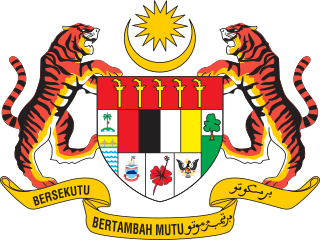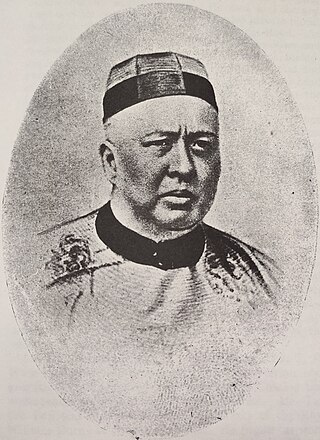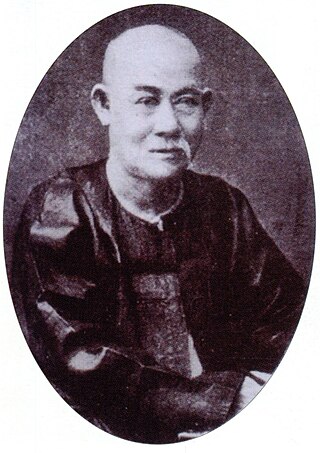
Perak is a state of Malaysia on the west coast of the Malay Peninsula. Perak has land borders with the Malaysian states of Kedah to the north, Penang to the northwest, Kelantan and Pahang to the east, and Selangor to the south. Thailand's Yala and Narathiwat provinces both lie to the northeast. Perak's capital city, Ipoh, was known historically for its tin-mining activities until the price of the metal dropped, severely affecting the state's economy. The royal capital remains Kuala Kangsar, where the palace of the Sultan of Perak is located. As of 2018, the state's population was 2,500,000. Perak has diverse tropical rainforests and an equatorial climate. The state's mountain ranges belong to the Titiwangsa Mountains, which is part of the larger Tenasserim Hills system that connects Myanmar, Thailand and Malaysia. Perak's Mount Korbu is the highest point of the range.

The Pangkor Treaty of 1874 was a treaty signed between Great Britain and the Sultan of Perak on 20 January 1874, on the Colonial Steamer Pluto, off the coast of Perak. The treaty is significant in the history of the Malay states as it legitimised British control of the Malay rulers and paved the way for British imperialism in Malaya. It was the result of a multi-day conference organised by Andrew Clarke, the Governor of the Straits Settlements, to solve two problems: the Larut War, and Sultanship in Perak.

William Alexander Pickering was the first Protector appointed on 3 May 1877 by the British government to administer the Chinese Protectorate in colonial Singapore. He was the first European official in Singapore who could speak fluent Mandarin and Hokkien and gained the trust of many of the Singapore Chinese. His efforts went a long way towards controlling the problems posed by the secret societies then. Pickering Street in Singapore's Chinatown is named after him.

Taiping is a town located in Larut, Matang and Selama District, Perak, Malaysia. It is located approximately 48 km (30 mi) northwest of Ipoh, the capital of Perak, and 78 km (48 mi) southeast of George Town, Penang. With a population of 245,182, it is the second largest town in Perak after Ipoh, the state capital.

The Ghee Hin Kongsi was a secret society in Singapore and Malaya, formed in 1820. Ghee Hin literally means "the rise of righteousness" in Chinese and was part of the Hongmen overseas network. The Ghee Hin often fought against the Hakka-dominated Hai San secret society.

The term "British Malaya" loosely describes a set of states on the Malay Peninsula and the island of Singapore that were brought under British hegemony or control between the late 18th and the mid-20th century. Unlike the term "British India", which excludes the Indian princely states, British Malaya is often used to refer to the Federated and the Unfederated Malay States, which were British protectorates with their own local rulers, as well as the Straits Settlements, which were under the sovereignty and direct rule of the British Crown, after a period of control by the East India Company.

Bukit Larut is a hill resort in Malaysia located in the state of Perak, Malaysia, 10 kilometres southwest from Taiping. It was established under the direction of British colonists in 1884 as a place of observation for tin mining activity and as a retreat for the English people who were based in nearby Larut and Taiping. The area was initially named Maxwell Hill after the British Malaya administrator George Maxwell, and was renamed as Bukit Larut in 1979.

The Klang War or Selangor Civil War was a series of conflicts that lasted from 1867 to 1874 in the Malay state of Selangor in the Malay Peninsula.

Kapitan China Chung Keng Quee was the founder and administrator of modern Taiping in Perak, Malaysia. Appointed "Capitan China" by the British in 1877, he was a millionaire philanthropist and known as an innovator in the mining of tin. He was involved in many other industries including farming, pawnbroking and logging. He was respected by both Chinese and European communities in the early colonial settlement. His survival in the chaotic era owes much to his standing as leader of the Hai San, a Chinese secret society in British Malaya during the time of the Larut Wars (1862–73). a position he is said to have held till early 1884 although in all probability he continued to remain a leading member. The old fort at Teluk Batu was built by him to safeguard the mine that he opened there. He was a member of the Commission for the Pacification of Larut and sat as one of six members of the Advisory Perak State Council appointed by the British. Commenting on the role of the Perak Council, Richard James Wilkinson wrote,
"It is for the reader, in the light of subsequent events, to judge how far the Councillors were right or wrong, and to see for himself who really did the pioneer work of building up the prosperity of Perak. In the published accounts of British rule in Malaya, sufficient prominence has not always been given to the efforts of these early pioneers; the reaper, intent on his own work, is apt to forget the man who sowed. These Council Minutes are the record of the work of the sowers. A study of that record will show how much the State owes to Sir Hugh Low and to his fellow-Councillors, especially Raja Dris, Sir William Maxwell, and the Chinese towkays, Ah Kwi [Chung Keng Quee] and Ah Yam."
Kota Ngah Ibrahim or Ngah Ibrahim's Fort is a fort of historical value in Taiping, Larut, Matang and Selama District, Perak, Malaysia. The fort is located at Jalan Taiping-Kuala Sepetang road near Matang town.

Tan Kim Ching, also known as Tan Kim Cheng, was a Chinese politician and businessman. He was the eldest of the three sons of Tan Tock Seng, the founder and financier of Tan Tock Seng Hospital. He was consul for Japan, Thailand and Russia, and was a member of the Royal Court of Siam. He was one of Singapore's leading Chinese merchants and was one of its richest men in Singapore at that time. He was also the first Asian member of the Straits Branch of the Royal Asiatic Society. After his father's death, he became the Kapitan Cina of the Straits Chinese community. He is believed to have been the head of the Triad in Malaya.

Samuel Dunlop, CMG served in several capacities as a member of the Straits Settlements civil service but is perhaps best known as the Inspector-General of Police, in Singapore.
The Second Larut War took place in 1865 and was sparked off by a gambling quarrel in June of that year between members of the two opposing secret societies.

The Hai San Society, which had its origins in Southern China, was a Penang-based Chinese secret society established around 1820 and in 1825 led by Low, Ah Chong and Hoh Akow, its titular head. At that time the society's headquarters was located at Beach Street.

Foo Tye Sin was a Justice of the Peace and an influential community leader of 19th century. Penang born Foo Tye Sin, a British subject, was a Hakka tin miner who could trace his ancestry to the Yong Ting District, Ting Chou Prefecture, Fujian. He was educated at St. Xavier's Institution and the Penang Free School. Tye Sin Street (四条路), or Lebuh Tye Sin as it is now known as, is named after him.

Khoo Thean Teik was one of the most powerful and notorious Hokkien leaders of 19th-century Penang. His name, "Thean Teik", means "Heavenly Virtue". He was the leader of the Tokong or Khian Teik society that was involved in the Penang Riots of 1867 and through its connection with the Hai San, the internecine Larut Wars of 1861 to 1874. He traded through the companies Khoon Ho and Chin Bee. He was a towkay, trading in immigrant labour and had interests in the Opium Farms in Penang and Hong Kong. Thean Teik Estate, a residential neighbourhood in Penang, and Jalan Thean Teik are named after him.
The Commission for the Pacification of Larut, whose terms of reference, among others, was to arrange for an amicable settlement relating to the Larut tin mines, was established by Sir Andrew Clarke on 23 January 1874. The members of the Pacification Commission included Captain Samuel Dunlop, Frank Swettenham, William A. Pickering, John Frederick Adolphus McNair, Chung Keng Quee and Chin Seng Yam. The Commission was successful in freeing many women taken as captives during the Larut Wars (1862–73), getting stockades dismantled and getting the tin mining business going again. The commission's labours concluded in February, 1874.
Ngah Ibrahim was a Malay headman who succeeded his father Long Jaafar as headman and administrator of the district of Larut upon the death of his father in 1857. By the time of Sultan Ismail Mu'abbiddin Riayat Shah of Perak, Ngah Ibrahim had quarrelled with Raja Muda Abdullah II, the son of the former sultan who had been passed over by the Royal Council in favour of Ismail. Abdullah sought to engineer a situation where the British would recognise him as Sultan and sought the services and recognition of Ngah Ibrahim. In return he appointed Ngah Ibrahim as Orang Kaya Mantri of Larut in 1858. The two of them had a falling-out and embroiled miners in the Larut area in their dispute which eventually resulted in intervention by the British, the treaties at Pangkor for the cessation of hostilities between the miners, the recognition of Abdullah as Sultan of Perak and the appointment of a British Resident whose advice must be asked and acted upon on all questions except those touching Malay religion and custom.

Sultan Abdullah Muhammad Shah II Ibni Almarhum Sultan Jaafar Safiuddin Muadzam Shah Waliullah was the 26th Sultan of Perak. He later played a prominent role of adopting the Perak's state anthem, Allah Lanjutkan Usia Sultan which was later used as the national anthem of Malaysia.

Perakian Malay people refers to a group of Malay people originating from the Malaysian state of Perak. As of 2010, it is estimated that the population of the Perakian Malays in Perak are about 55.74% of the state's population.















